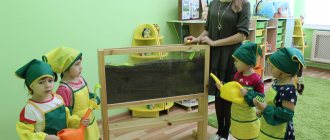Preparatory stage
Speech development in preschool age begins before one year of age. During the period from birth to 12 months, the speech apparatus is formed, as well as its preparation for correct articulate pronunciation.
Thanks to screaming and crying, the baby tries to convey his needs. Mothers know how to determine when crying is caused by negative emotions, and when, on the contrary, it is accompanied by joy and greeting.
Buzzing occurs between the ages of two and seven months. It is considered to be the baby's first conversations. The baby can already combine vowels and consonants, for example, “agu”, “abu”. The most incredible thing is that by the nature of the hum and intonation you can guess what nationality the child belongs to. After all, at this age it is already common for a child to master the emotional specifics of his native speech.
The next leap in speech development is babbling. It starts from the fourth month. It can be noted that repeated syllables become emotional. Forelingual and labial consonants appear, for example, “ma-ma-ma.”
The baby can begin to speak his first words at the age of 11 to 12 months. Of course, these are extremely short and simple words (um, yum, mom, give). But the baby uses them with understanding, and sometimes even accompanies the pronunciation with gestures.
Upon reaching the age of one, children master stressed and final syllables. And the pronunciation of most words can already be called quite legible and understandable.
Training techniques for different types of speech for children
To develop different types of speech in children, special training is needed.
Stage speech for children
Stage speech is the basis for the development of acting skills for children, so it is better to train it in preschool age. Stage speech exercises develop the speech apparatus, train diction and articulation, teach you to reflect emotions, control intonation and use it to convey shades of mood.
Scenic speech
Important! Tongue twisters and special games that develop diction and pronunciation are best suited for training stage speech.
Examples of several exercises:
- Depict various emotions through facial expressions and gestures (sadness, joy, anger, surprise, etc.)
- Pronounce phrases with different intonations, emphasizing the main word in the sentence. "Hooray! Summer is coming soon!" - joyfully, sadly, scared, with a questioning intonation, like a grandfather.
- Clearly articulating, pronounce tongue twisters. In this case, you need to change the stressed word in the sentence each time, paying attention to the appearance of new shades in the tongue twister. Examples: “The cuckoo bought a hood,” “The jackdaw sat on the fence, the rook started a conversation with her,” “The centipedes have too many legs.”
There are entire collections of exercises and methods for teaching children expressiveness that you can buy or find on your own, and in kindergartens and clubs there are additional courses and consultations for parents that teach this.
Diction exercises for children
Diction is an important tool for understanding other people’s speech, which is why it is so important to work with your child on it from an early age, because in the future, unclear speech can cause ridicule from peers and personal insecurity.
Note! Clear, understandable speech is the key to the attractiveness of any person, which is formed in childhood; experts recommend working with children with poor diction at the age of 2-3 years, otherwise it will become much more difficult to correct it later.
A similar problem is immediately noticeable by ear, but nevertheless, the main indicators of unclear diction in children are:
- Incorrect sound pronunciation
- replacing a voiceless consonant with a voiced one
- abbreviation of difficult to pronounce words
- replacing one sound with another
- and others.
Diction exercises are aimed at strengthening the facial and oral muscles, because you need to learn how to quickly change the position of your lips and tongue.
Famous diction exercises for children:
- Tube. Fold your lips into a tube, stretching them forward, and thus pronounce the sound “u”.
- Smile. You need to smile very widely, without opening your lips.
- Horn. Open your mouth wide and pronounce the sound “a”.
- Bagel. It is necessary to stretch your lips as far as possible, tensing the muscles around you, and pronounce the sound “o”.
- Drummer. You need to hit your upper teeth with your tongue and pronounce “d” along with it.
- Sweetie. Without opening your mouth, rest your tongue on one or the other cheek.
- Spatula. Try to reach the tongue either to the nose or to the chin.
- Needle. With your mouth open, extend your tongue forward as far as possible.
- Horse. Teach a child to click his tongue on the upper palate.
Technological map of classes on speech development in the senior group
Articulation exercises
Another type of facial muscle training is articulation gymnastics, which also improves the mobility of the tongue and lips.
Important! Experts recommend doing a small articulatory warm-up first, spending about 5 minutes on it.
Articulation warm-up technique:
- Imagine that there is a ball of air in your mouth and move it from one cheek to the other, then under the upper and lower lips.
- Pull in and puff out your cheeks.
- Move your lower jaw in a circle, up and down, to the sides, back and forth.
- Pretend to yawn by opening your mouth wide.
- Imitate the sound of gargling.
- Alternately touch the palate and the base of the lower teeth, straining the tongue.
- Warm up your lips by stretching them with a tube.
- Imitate the snorting and neighing of a horse.
- Pull your upper or lower lip over your teeth and slide it.
- Reach your tongue either to the chin or to the nose.
- Turn your tongue in your mouth now to the right, now to the left.
- Pull your tongue forward as far as possible.
Exercises for beautiful articulation:
Warm up the tip of the tongue. Hit the teeth with the tip of your tongue, while straining your tongue and pronouncing the syllable “yes” in a row. Then practice pronouncing the consonants “t” and “d”.
Tongue Twisters.
- A stupid, stupid, stupid bull.
- Greek rode across the river.
- Masha walked along the highway and sucked on the dryer.
- (You should begin to pronounce tongue twisters as slowly as required for the most understandable sound of the text. It is also necessary to pay special attention to expressiveness and intonation. You can ask the child to gradually increase the speed of pronunciation.)
Lip exercise.
- Pursing your tense lips inwards, sharply throw the air out of your mouth. A pop should be heard. Together with the exercises, you can practice pronouncing “p” and “b”.
Highlighting endings.
- Sharply highlight the ending of a word, exaggerating the pronunciation of the last sounds and placing emphasis on them.
Exercise for the lip muscles.
- Quickly pronounce the vowels “a” “i” “u” “e” “o” alternately.
Initial speech acquisition
The main development of speech in children of primary preschool age occurs in the period from one to three years and has a number of features.
Before starting to speak independently, the child learns to understand the speech of the people around him. It is considered normal when a child aged one and a half years has several basic words in his vocabulary, such as: dad, mom, give, aunt, uncle. Parents and close people are role models for children in everything. Therefore, it is very important to comment on everything you do. It is already common for a child to understand everything and remember important information.
At the age of about 1.5 years, babies cannot yet generalize words. Therefore, the word “yum” can mean not only a desire to eat, but also a request to hold a spoon or try to eat on your own. Also, children of this age tend to discard endings. You may have noticed that your child pronounces some words as if trying to ignore certain syllables or letters. There is no need to worry about this as long as such shortcomings are considered normal. Over time, the child will learn to pronounce sounds and words correctly. In the meantime, the parents' task is to explain to the child how to do it correctly.
The process of speech development in preschool age should be accompanied by frequent conversations with the baby. Moreover, it is very important to use gestures during a story or explanation. It is very important for a child to monitor facial expressions, pronunciation and emotional components. Show and name objects that come into your field of vision. While walking, talk about nature, dogs, cats and birds that you see regularly. Such events are not only remembered by the child, but also provide significant assistance in the development of the speech apparatus.
Once children reach the age of two, they can easily distinguish intonation. Therefore, it is very important to change the timbre of your voice when reading a fairy tale. For example, a bear speaks in a deep voice, and a mouse quietly squeaks in a tiny voice. Children love this role-playing accompaniment. Moreover, it is easier for them to understand what is happening in the story.
The development of speech in children of primary preschool age after two and a half years is accompanied by the ability to speak in phrases. Typically sentences consist of 2-3 words. He masters the pattern of matching different words with each other. Already able to understand the difference between singular and plural. The baby begins to actively use a certain system of perception, which becomes the main foundation for the transition to the next stage of speech development.
Main types of speech and their characteristics
Below are the main types of speech and their characteristics.
Primary type of speech
Psychology divides human speech activity into two categories: internal and external.
Teacher's lesson with a child
Internal
It is associated with the thinking process, is not formalized orally or in writing, and is not a means of communication. It is figurative, fragmentary, it involves only words that convey the essence of the thought, so the speed of transmission is fast.
Inner speech performs an important preparatory function before the actual voicing of thoughts; thanks to it, “outlines” of statements are compiled.
External
Associated with the process of communication: spoken, written or read. Subtypes of external speech are oral and written.
Written
Formatted using written characters in compliance with grammatical rules. A clear construction of phrases, a thoughtful presentation of thoughts, and coherence of the resulting text are required. Written speech includes both writing itself and reading.
Conversational (dialogue)
A type of oral speech in which a conversation is carried on by two people, using simple phrases and turns of phrase. Does not require detailed expressions and is easily understood by the interlocutor.
Monologue
Refers to oral form, pronounced by one person.
Example: speech by a lecturer, speaker.
A monologue is close to written speech, due to the lack of feedback from the interlocutor. Compliance with the same rules as when writing is required: consistent mental presentation, logic, and the ability to coherently convey information. A monologue is considered a more complex type of speech than dialogue; it involves contact with the audience and requires preparation.
Schematic explanation of speech structure
Thus, answering the question “What type of speech is primary in the development of a child’s speech activity?”, we can definitely talk about the oral conversational form. It is genetically primary: first, the child masters dialogue (from infancy through interaction with adults). And only then does he learn to organize thoughts in a monologue and writing. To prove the thesis, one can cite the fact that there are still languages and dialects that function only through oral communication. Oral speech is natural in nature, written language is its derivative.
Interesting fact! A large group of people for whom the main form of communication is neither oral nor written speech is the deaf and mute, who do not have hearing or voice from birth, or who have lost them as a result of accidents. For them, the main type of information transfer remains kinetics - gestures, signs. Historically, kinetic speech is the primary type of communication that has existed since ancient times. But, of course, it is not worth comparing the communications of the deaf and dumb with the way of communication of primitive people. The speech of mutes is characterized by complexity and systematization of signs and concepts.
Development of a child’s speech forms in a preschool educational institution
Kindergarten is the place where the development of a child’s personality begins. The professional competence of teachers plays a huge role in this process. The development of coherent speech in the form of constructing dialogues and monologues, laying the prerequisites for writing is one of the primary tasks of a preschool educational institution.
Speech development in the middle group of kindergarten - norms and features
It is important to understand! This is not a narrowly focused activity, but a whole range of measures taken by specialists, requiring creative solutions. A modern approach to working and teaching both children and teachers themselves is important.
To date, the Federal State Standard of Preschool Education (FSES DO) has been developed and introduced, which identifies the main areas of child development:
- Social and communicative development,
- Cognitive,
- Speech development,
- Artistic and aesthetic,
- Physical.
Factors influencing speech development
Educational field "Speech development" according to the Federal State Educational Standard for Education
This standard implies competent work by specialists to help children master the following areas:
- Free expression of thoughts and feelings to establish contact with other children and adults.
- Replenishment of vocabulary, the ability to combine words into sentences, change the form of words, i.e. mastering the grammatical structure.
- Development of creativity, the ability to compose short stories, think through the plots of fairy tales.
- Mastering the stress system, correct pronunciation of sounds, the ability to speak expressively and read poetry.
- Studying letters, word morphology, syntactic rules, preparing for literacy, mastering the basics of writing.
- Gaining experience in reading books.
Federal State Educational Standard for Additional Education on Speech Development
From 3 to 7 years
The development of coherent speech in preschool children occurs over a period of three years. At this age, the baby can easily describe an object and even construct a short description regarding a picture in a book. During this period of time, it is very important for parents to answer all the child’s questions. And there will be a lot of them. In addition, you can already use role-playing games with toys. Such interaction has a positive effect on speech development in preschool age.
At 4-5 years old, it is considered normal for a story or description of an object to be understandable not only to parents, but also to those around them. Moreover, the child speaks not only in sentences, but also knows how to imitate the voices of different animals.
Despite the fact that the child is constantly bombarded with a number of new phrases and words, he easily distributes and classifies them according to the necessary criteria. This is how his vocabulary is formed. A child’s speech at this age is formed quite simply.
Interesting fact! Being a linguist, K.I. Chukovsky determined why children tend to create new special children's adverbs every minute. And it turned out that kids create such neologisms not by chance. They sort words according to their logical meaning, following grammatical rules. As a result, we can hear how crackers become “kusariki” due to the semantic understanding of the meaning of the word “bite”. And a dog with long hair may be called “shaggy” by children.
Psychological features of speech development in preschool children November 2021
Psychological features of speech development in preschool children
Preschool age is a period of active acquisition of spoken language by a child, the formation and development of all aspects of speech. The sooner learning the native language begins, the more freely the child will use it in the future.
In preschool children, speech has an important influence on the development of sensations and perceptions and contributes to the formation of thinking. Thanks to speech, ideas about the world around us develop and memory improves.
As the lexico-grammatical side of speech develops, the child masters such intellectual operations as comparison, analysis and synthesis.
Speech is one of the indicators of child development. Speech accompanies all types of activity.
It fulfills several needs of the child: communicative, informative, cognitive (developmental), which already speaks of its great significance.
The primary function of speech is communicative. Without the development of speech, full communication of a person in society is impossible. Language development is at the center of a child's learning.
Work on the development of children's speech must be comprehensive and solve problems associated with all aspects of speech development - phonemic, lexical, grammatical. A comprehensive influence on a child’s speech is a prerequisite for the development of coherent speech. In addition, it is the adult who awakens the child’s interest in language and encourages him to be creative.
Timely and complete development of speech in preschool age is one of the main conditions for the normal development of a child and his subsequent successful education at school. Modern means started from the first days of a child’s life. Comprehensive means a sufficient amount of language material, encouraging the child to master speech to the best of his ability at each age level.
Any delay and any disturbance in the development of a child’s speech is reflected in his behavior, as well as his activity in its various forms.
Speech is not an innate ability, but develops in the process of ontogenesis (individual development of the body from the moment of its inception to the end of life.) in parallel with the physical and mental development of the child and serves as an indicator of his overall development. A child’s acquisition of his native language follows a strict pattern and is characterized by a number of features common to all children. In order to understand speech pathology, it is necessary to clearly understand the entire path of sequential speech development of children in normal conditions, to know the patterns of this process and the conditions on which its successful occurrence depends.
In addition, you need to clearly imagine each stage of the child’s speech development, each “qualitative leap” in order to notice in time certain deviations in this process. For example, a baby is 1 year 4 months. doesn't speak yet. The teacher can decide whether this phenomenon is normal or not only if he knows when, during normal development, the first words should appear.
Knowledge of the patterns of speech development in children is also necessary for the correct diagnosis of speech disorders. Thus, some experts sometimes refer three-year-old children to a speech therapist to eliminate deficiencies in the pronunciation of sounds. Is it correct? No. Because even with normal speech development, a child at a given age is “supposed” to pronounce some sounds incorrectly. This phenomenon, called physiological tongue-tiedness, is completely natural and is due to the still insufficient formation of the articulatory apparatus.
And finally, knowledge of the laws of development of children’s speech in the process of ontogenesis is also necessary in order to correctly construct all correctional and educational work to overcome speech pathology. For example, when teaching non-speaking children (alaliks), it is very important to know that first every child develops an understanding of speech and only then does he master active speech. Consequently, if in this case you immediately develop active speech, the work will not bring the desired effect.
A. N. Leontyev establishes four stages in the development of children’s speech:
1st - preparatory - up to one year;
2nd - pre-preschool stage of initial language acquisition - up to 3 years;
3rd - preschool - up to 7 years;
4th - school.
Let us dwell in detail on the characteristics of these stages.
So, the first stage is preparatory (from the moment the child is born to one year).
Why is this stage called this? Because at this time preparation for mastering speech occurs. What is it?
From the moment of birth, the child develops vocal reactions: screaming and crying. True, they are still very far from the sounds of human speech. However, both screaming and crying contribute to the development of subtle and varied movements of the three sections of the speech apparatus: respiratory, vocal, articulatory.
After two weeks, you can already notice that the child begins to respond to the speaker’s voice: he stops crying, listens when he is addressed. By the end of the first month, he can already be calmed down with a melodic song (lullaby). Next, he begins to turn his head towards the speaker or follow him with his eyes. Soon the baby already reacts to intonation: to a gentle one he becomes animated, to a harsh one he cries.
About 2 months humming appears and by the beginning of the 3rd month. - babble (agu-huh, cha-cha, ba-ba, etc.). Babbling is a combination of sounds that are vaguely articulated.
From 5 months the child hears sounds, sees articulatory movements of the lips of others and tries to imitate. Repeated repetition of a specific movement leads to consolidation of a motor skill.
From 6 months The child pronounces individual syllables by imitation (ma-ma-ma, ba-ba-ba, cha-cha-cha, pa-pa-pa, etc.).
Subsequently, through imitation, the child gradually adopts all the elements of spoken speech: not only phonemes, but also tone, tempo, rhythm, melody, intonation.
In the second half of the year, the baby perceives certain sound combinations and associates them with objects or actions (tick-tock, give-give, bang). But at this time he still reacts to the entire complex of influences: the situation, intonation and words. All this helps the formation of temporary connections (memorizing words and reacting to them).
At the age of 7 - 9 months. the child begins to repeat more and more diverse combinations of sounds after the adult.
From 10 - 11 months. reactions to the words themselves appear (regardless of the situation and intonation of the speaker).
At this time, the conditions in which the child’s speech is formed (correct speech of others, imitation of adults, etc.) become especially important.
By the end of the first year of life, the first words appear.
The second stage is pre-preschool (from 1 year to 3 years).
With the appearance of the child’s first words, the preparatory stage ends and the stage of development of active speech begins. At this time, the child develops special attention to the articulation of those around him. He very much and willingly repeats after the speaker and pronounces the words himself. At the same time, the baby confuses sounds, rearranges them, distorts them, and omits them.
The child’s first words are of a generalized semantic nature. With the same word or sound combination it can denote an object, a request, or feelings.
- For example, the word porridge can mean porridge at different moments; give me some porridge; hot porridge.
- Or the word papa can mean papa came; no dad; dad, come over, etc.
It is possible to understand a child only in a situation in which or about which his communication with an adult takes place. Therefore, such speech is called situational. The child accompanies situational speech with gestures and facial expressions.
From the age of one and a half years, the word acquires a generalized character. It becomes possible to understand an adult’s verbal explanation, assimilate knowledge, and accumulate new words.
During the 2nd and 3rd years of life, the child experiences a significant accumulation of vocabulary.
It should be noted that various researchers (both ours, domestic and foreign) provide different quantitative data on the growth of children’s vocabulary.
Let us present the most common data on the rapid development of children's vocabulary in the preschool period: by 1 year 6 months. - 10 - 15 words; by the end of the 2nd year - 300 words (in 6 months about 300 words!); by year 3 - about 1000 words (i.e. about 700 words per year!).
The meanings of words become more and more defined.
By the beginning of the 3rd year of life, the grammatical structure of speech begins to form in the child.
First, the child expresses his desires and requests in one word. Then - in primitive phrases without agreement (“Mom, give Tata something to drink” - Mom, let Tata drink some milk). Next, elements of coordination and subordination of words in the sentence gradually appear.
The third stage is preschool (from 3 to 7 years).
At the preschool stage, most children still have incorrect sound pronunciation. You can detect defects in the pronunciation of whistling, hissing, sonorant sounds r and l, and less often - defects in softening, voicing and iotation.
Over the period from 3 to 7 years, the child increasingly develops the skill of auditory control over his own pronunciation, the ability to correct it in some possible cases. In other words, phonemic perception is formed.
During this period, the rapid increase in vocabulary continues. By the age of 4–6 years, a child’s active vocabulary reaches 3000–4000 words. The meanings of words are further clarified and enriched in many ways. But often children still misunderstand or use words, for example, by analogy with the purpose of objects, they say “pour” instead of watering from a watering can, “dig” instead of a shovel, etc. At the same time, this phenomenon indicates a “sense of language.” This means that the child’s experience of verbal communication grows and on its basis a sense of language and the ability to create words are formed.
K. D. Ushinsky attached special importance to the sense of language, which, according to him, tells the child the place of emphasis in a word, grammatical expression, and the way of combining words in a sentence.
In parallel with the development of vocabulary, the development of the grammatical structure of speech also occurs. During the preschool period, children master coherent speech. After three years, the content of the child’s speech becomes significantly more complex and its volume increases. Children of the 4th year of life use simple and complex sentences in speech. The most common form of statements at this age is a simple common sentence (“I dressed the doll in such a beautiful dress”; “I will become a big strong uncle”).
At the age of 4-5 years, when the child already has a good command of speech and can talk with an adult on abstract topics, non-situational-cognitive communication becomes possible. The child acquires a sufficient vocabulary and begins to construct phrases grammatically correctly and pronounce sounds normally. The active vocabulary that a child has at the age of 4 gives him the opportunity to freely communicate with others. But he often experiences difficulties due to the insufficiency and poverty of the vocabulary when he needs to convey an event in which he himself was a participant. Here the baby often makes inaccuracies. In the process of mastering new words, the child not only memorizes them, he begins to comprehend their sound side, tries to establish a closer connection between the object and the word denoting it, strives in his own way to understand the names of certain objects, actions, i.e. The child develops a motivated attitude towards vocabulary. At this age, the child is not yet able to independently talk logically, coherently and clearly for others about the events he witnessed; he cannot intelligently retell the content of a fairy tale or story read to him. His speech is still situational. The child’s utterances consist of simple common sentences, often only distantly related in content. It is not always possible to understand their content without additional questions. There is still no development in the utterance that is characteristic of monologue speech.
At 5 years of age, children are relatively fluent in using the structure of compound and complex sentences (“Then, when we went home, they gave us gifts: various candies, apples, oranges”; “Some smart and cunning guy bought balloons, made candles, threw into the sky, and it turned out to be a fireworks display").
Starting at this age, children's statements resemble a short story. During conversations, their answers to questions include more and more sentences.
At the age of five, children, without additional questions, compose a retelling of a fairy tale (story) of 40 - 50 sentences, which indicates success in mastering one of the difficult types of speech - monologue speech.
During this period, phonemic perception improves significantly: first, the child begins to differentiate vowels and consonants, then soft and hard consonants, and finally, sonorant, hissing and whistling sounds.
By the age of 4, a child should normally differentiate all sounds.
that is, he must have developed phonemic perception.
By this time, the formation of correct sound pronunciation ends and the child speaks completely clearly.
During the preschool period, contextual (abstract, generalized, devoid of visual support) speech is gradually formed. Contextual speech appears first when the child retells fairy tales and stories, then when describing some events from his personal experience, his own experiences, impressions.
Having a good memory, a child is able to remember and reproduce short poems, and after listening to the same fairy tale repeatedly, he can convey its content almost word for word, often without even understanding the meaning of the words.
Normal (timely and correct) speech development of a child allows him to constantly learn new concepts, expand his stock of knowledge and ideas about the environment. Thus, speech and its development are most closely related to the development of thinking.
Thus, preschool childhood is a period of intensive development of communicative forms and functions of language activity, practical speech skills, and awareness of speech activity.
The following types of disorders occur in preschool age:
— DYSPHONIA / APHONIA / - absence or disorder of phonation due to pathological changes in the vocal apparatus. They manifest themselves in the absence or violation of the strength, pitch, and timbre of the voice.
— BRADYLALIA is a pathologically slow rate of speech.
- TACHILALIA - pathologically accelerated rate of speech.
— STUTTERING is a violation of the tempo-rhythmic organization of speech, caused by the convulsive state of the muscles of the speech apparatus.
-DYSLALIA is a violation of sound pronunciation with normal hearing and intact innervation of the speech apparatus.
— DYSARTHRIA - a violation of sound pronunciation caused by insufficient innervation of the speech apparatus. (organic)
— RINOLALIA - a violation of sound pronunciation and timbre of the voice, caused by anatomical and physiological defects of the speech apparatus.
- ALALIA - absence or underdevelopment of speech due to organic damage to the cerebral cortex in prenatal or early periods of development.
— DELAYED SPEECH DEVELOPMENT (RDD) - the slowest rate of mastery of the native language compared to the norm.
— PHONETIC-PHONEMATIC UNDERDEVELOPMENT (FFN) is a violation of the processes of formation of the pronunciation aspect of the native language in children with various speech disorders associated with defects in the perception and pronunciation of sounds.
— GENERAL SPEECH IMPORTANCE (GND) is a complex speech disorder in which children have impaired formation of all components of speech (vocabulary, grammar, phonetics, semantics) with normal hearing and intelligence.
Each group of defects differs in form and degree of severity. The nature of correctional work, forms and methods, as well as timing depend on this.
It is also necessary to touch upon such an important element as the prevention of speech disorders. If it is not carried out, then transitions of certain disorders to written speech (DYGRAPHIA, DYSLEXIA) or layering of secondary disorders on primary ones are possible. And this is an even more complex correction process. Therefore, it is advisable to eliminate all speech disorders in preschool age.
Stimulation
Features of the speech development of preschool children directly depend on their environment. After all, it is from their family and friends that they learn their first words. During this period, it is very important to present information to the child with correct and clear audio.
Therefore, experts say how important it is to talk to your baby as often and as much as possible. There are a huge number of beautiful books with bright drawings and children's cards. Thanks to such auxiliary tools, it is possible to stimulate speech development in preschool age. Any pictures can be discussed with your child. It is not necessary to read the description or text nearby. Give your child the opportunity to imagine. Let him tell you what he sees. If the baby does not make contact, then try to start first.
The psychology of child development confirms the fact that speech is continuously connected with the fine motor skills of the child. This conclusion is based on the knowledge that the speech and motor centers of the brain are located nearby. Therefore, it is very important to use finger games during the period of speech development. The most popular are modeling and finger painting using special paints. Picking through cereals, buttons and other details is considered to be an equally good activity. Let your child sort them by color and size.
When is it time to worry
Speech development in early preschool age does not always go smoothly. The baby’s abilities can be assessed at the age of one year. You should start to worry if a baby at this age does not respond to sounds and cannot pronounce them independently. Normally, a child at the age of 12 months should actively use gestures in communication (waving a hand, pointing with a finger, etc.).
With proper development, a baby aged 1.5 years and older can easily imitate the sounds of animals (meow, woof, mu, be, me), and also easily perceive and understand requests.
By the time parents reach two years of age, they should be able to easily understand at least half of the words their child speaks.
And it is at the age of two years that the psychological and pedagogical commission at a preschool educational institution can diagnose a child with delayed speech development. It is important to understand that this is not a death sentence, and most often this diagnosis is removed by 4-5 years. Quite recently, it was customary to give ZRR to all two-year-old children whose vocabulary was less than 200 words. Today these figures have decreased significantly. And a child of this age only needs to pronounce about 50 words, including onomatopoeia and babble. The ability to formulate two-part constructions also testifies to the normal development of children.
Remember that the role of speech development in preschool age is not exaggerated. That is why it is important to follow the basic rules. Remember that you should not leave the TV on continuously in the room where your baby spends the most time. This sound background does not bring any benefit, but only prevents the baby from developing communication skills. In addition, extraneous sounds and noise prevent the child from talking. Because instead of activating his own speech, he has to be involved in the listening process.
Methods for developing speech in preschool children
Visual modeling is considered an effective way to correct speech in children. Thanks to this technique, the child begins to imagine abstract phenomena associated with words and sounds. It is this approach that makes it much easier for a child to understand the process.
The essence of this means of developing the speech of preschool children is to demonstrate the properties of the object under discussion. Let’s say a speech therapist works with a child aimed at correcting a violation of the syllabic component. To do this, he can involve the child in a game called “Pyramid”. The essence of it is that you need to figure out in what sequence the pictures should be arranged in relation to the rings, and do this in practice. Let's say the bottom ring contains words with one syllable, the middle ring contains words with two syllables, and the third ring contains words with three syllables.
Theater and rhetoric
Methods for developing the speech of preschool children are based on a variety of games. An important aspect in this matter is considered to be the return from the child. That is, if the baby is not interested in the process, then the result should not be expected.
In the process of playing, aimed at acting out fairy tales, stories or stories, the baby develops the ability to sequentially list events, retaining this information in his mind. When children write their own scripts for puppet shows, they learn to create a plot that is built on the plot, exposition, development, climax and denouement. According to this sequence of events, both the introduction and the speech can be structured.
An equally attractive way is to develop the speech of preschool children through retelling. These can be well-known fairy tales and stories that can be taken as the basis for the script for the play.
By choosing fairy tales, children learn to understand the themes of the texts, as well as to select and systematize the material presented. In addition, they actively edit the acquired knowledge using their additions. They easily convey the emotional component of their hero and change the timbre of their voices for each of the characters.
You can make a puppet theater for a child yourself, or you can purchase a ready-made set at a children's store. Such educational toys are developed based on the recommendations of famous child psychologists. The most interesting are the finger characters. The child actively uses fine motor skills while playing. The development of speech in children of senior preschool age can be accompanied by a puppet theater with toys that are put on the hands, especially since many children at the age of five can already read independently. And the set is almost always supplemented with a book with bright pictures. The stories and fairy tales written in it can be safely taken as the basis for the script. Of course, it wouldn’t hurt to invite your child to dream up their imagination and make their own adjustments to the script. Give him the opportunity to reflect and make decisions about what he would correct in this story.
Speech therapy massage
When parents are faced with the goal of developing the speech of preschool children, a lot of methods and methods are used. Speech therapy massage is considered one of the most popular. Typically, most people associate such manipulation with a therapeutic effect. But it should be noted that massage has a direct effect on brain activity. It tones the central nervous system and also strengthens the nerve connections between the brain and muscles with blood vessels.
Methods have been developed that have a positive effect on memory, analytics and thinking of the human brain, as well as on speech.
An experiment was conducted on the development of coherent speech in children of senior preschool age. For eight months they underwent a special massage course. And after 21 days, excellent changes in brain activity were noticed in most children. Children have more interests and hobbies. Overall, the result of this experiment showed an increase in mental abilities by 75%.
A total of 6 massage courses were conducted. Each of them consisted of 10 sessions and took no more than 10 minutes. Moreover, the child will be able to repeat such a massage on his own over time.
Methods for examining the speech of preschool children
Diagnosis of speech development in children of early and preschool age is carried out according to the following parameters:
- Child's dictionary.
- Sound culture of speech.
- Grammar.
- Development of coherent speech.
Used literature on the topic: Gribova O. E., Bessonova T. P. “Didactic material on examining children’s speech”
Specialists should evaluate a child's skills only using appropriate diagnostic materials that help them objectively approach the assessment of children's speech abilities. To select instruments and examination technologies, it is recommended to use the methodological literature of Gribov and Bessonov “Didactic material for examining children’s speech.”
It is presented in three directions:
- "Lexicon",
- "Grammar structure"
- “Sound Side” part 1, part 2.
Recommended teaching materials
Survey of the sound culture of children's speech
The concept of “sound side” refers to sound pronunciation. Diagnosis of the sound culture of speech of preschoolers should be carried out by a speech therapist twice a year: in the fall - when drawing up a plan for correctional work, and in the spring - when summing up the results.
Important! During the study of sound pronunciations, the teacher should note the following indicators: which sounds were pronounced correctly, whether there are violations of the syllabic structure of words, whether the child can regulate the strength of the voice, tempo, whether there were any omissions in sound pronunciation correction, active or passive speech activity.









